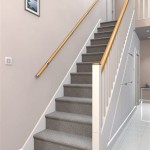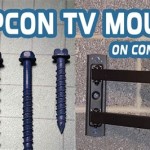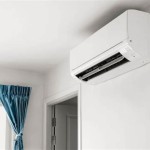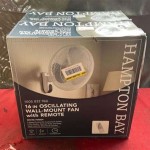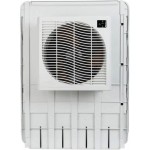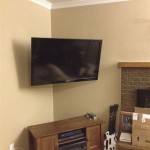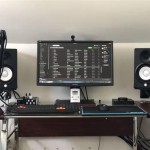Wall Mount TV Stand Ideas: Optimizing Space and Style
Wall mounting a television can significantly improve the aesthetics and functionality of a living room, bedroom, or entertainment space. It not only saves floor space but also allows for a more customized viewing experience and can contribute to a cleaner, more modern look. Integrating a wall-mounted TV with a complementary stand further enhances the setup, providing storage, concealing cables, and adding a decorative element. The following explores various wall mount TV stand ideas, considering different styles, functionalities, and installation considerations.
Floating Shelves and Minimalist Designs
One popular approach involves pairing a wall-mounted television with floating shelves. This minimalist design offers a clean and uncluttered look, suitable for contemporary interiors. Floating shelves can be arranged in various configurations, from a single long shelf beneath the TV to a staggered arrangement of multiple shelves. The shelves provide a space for media players, gaming consoles, decorative items, and books. Material choices greatly impact the overall aesthetic. Wood shelves, whether natural or stained, offer warmth and texture, while glass or metal shelves contribute to a more modern, industrial feel. The load-bearing capacity of the shelves is a crucial consideration, ensuring they can safely support the intended items. Furthermore, cable management is paramount. Running cables inside the wall cavity, if feasible, eliminates visible wires. Alternatively, using cable concealers or strategically placing decorative items can minimize the visual impact of cables.
The installation of floating shelves typically involves mounting brackets directly to wall studs. Using a stud finder is essential to ensure secure attachment. For drywall-only installations, heavy-duty drywall anchors provide additional support. Precise measurements and leveling are critical for a professional and aesthetically pleasing result. Before installation, it's advisable to plan the shelf arrangement and mark the positions on the wall. Consider the height of the TV and the desired spacing between the TV and the shelves. This planning stage minimizes errors and ensures a balanced visual composition. The depth of the shelves should be proportionate to the size of the TV and the room. Overly deep shelves can make the space feel cramped, while shallow shelves may not provide adequate storage. The overall goal is to create a harmonious balance between the TV and the surrounding elements.
Color coordination plays a vital role in integrating floating shelves into the room's décor. Matching the shelf color to the wall color creates a seamless and understated look. Alternatively, using contrasting colors can add visual interest and highlight the shelves as a focal point. The choice of hardware, such as brackets and screws, also contributes to the overall aesthetic. Concealed brackets provide a cleaner look, while decorative brackets can add a touch of personality. The style of the hardware should complement the style of the shelves and the room's overall design. Lighting can further enhance the floating shelf arrangement. Installing LED strip lights behind the shelves creates a soft, ambient glow, highlighting the displayed items and adding a touch of sophistication.
Closed Cabinets and Storage Solutions
For those seeking more comprehensive storage, closed cabinets offer a practical solution. These cabinets provide ample space for media equipment, DVDs, gaming accessories, and other items, keeping them neatly organized and out of sight. Wall-mounted cabinets can be custom-built or purchased as pre-fabricated units. Custom-built cabinets offer the advantage of tailoring the size, configuration, and finish to perfectly match the room's dimensions and décor. Pre-fabricated cabinets, on the other hand, offer convenience and can be a more cost-effective option. The choice depends on budget, design preferences, and the level of customization required.
When selecting wall-mounted cabinets, consider the type of doors. Hinged doors, sliding doors, and drop-down doors each offer different advantages. Hinged doors provide easy access to the contents of the cabinet, while sliding doors save space and are ideal for smaller rooms. Drop-down doors can be used to create a temporary shelf or work surface. The internal configuration of the cabinets is also important. Adjustable shelves, drawers, and compartments allow for flexible storage options. Cable management is a critical consideration for cabinets housing media equipment. Ventilation holes or slots are necessary to prevent overheating. Cable pass-throughs allow for easy connection of devices without creating a tangle of wires. The placement of the cabinets should be carefully considered to ensure easy access and optimal viewing angles.
The installation of wall-mounted cabinets requires careful planning and execution. Similar to floating shelves, it's essential to locate wall studs and use appropriate mounting hardware. The weight of the cabinets, especially when fully loaded, can be significant. Therefore, it is imperative to use heavy-duty brackets and anchors. Leveling the cabinets is crucial for a professional and aesthetically pleasing result. Before installation, it's advisable to assemble the cabinets and test their functionality. This ensures that all doors and drawers operate smoothly and that there are no manufacturing defects. The finish of the cabinets should complement the wall color and the overall décor of the room. Matching the cabinet color to the wall color creates a cohesive and seamless look. Alternatively, using contrasting colors can add visual interest and highlight the cabinets as a focal point.
Integrated Media Walls and Custom Designs
For a more elaborate and personalized solution, an integrated media wall offers the ultimate in customization and functionality. An integrated media wall typically spans a large portion of the wall and incorporates the television, storage cabinets, shelving, and other decorative elements into a cohesive design. This approach allows for a seamless and unified look, transforming the entire wall into a focal point. Integrated media walls can be custom-built to meet specific needs and preferences, incorporating features such as built-in lighting, sound systems, and even electric fireplaces.
The design process for an integrated media wall involves careful planning and collaboration with a designer or contractor. The size of the room, the viewing distance, and the desired storage capacity are all important factors to consider. The design should also take into account the existing architectural features of the room, such as windows, doors, and fireplaces. The choice of materials and finishes is crucial for creating the desired aesthetic. Wood, metal, glass, and stone can all be incorporated into the design. The color palette should complement the overall décor of the room. Lighting plays a key role in enhancing the visual appeal of an integrated media wall. Recessed lighting, spotlights, and LED strip lights can be used to highlight specific features and create a dramatic effect.
The installation of an integrated media wall is a complex undertaking that typically requires professional expertise. The construction process involves framing, wiring, and finishing. It's essential to use high-quality materials and ensure that all work is performed to code. Cable management is a critical aspect of the installation. All cables should be concealed within the wall cavity or behind panels. Adequate ventilation is necessary for media equipment to prevent overheating. The cost of an integrated media wall can vary significantly depending on the size, complexity, and materials used. However, the investment can be well worth it for those seeking a truly customized and high-end entertainment solution. The result is a stunning and functional space that enhances the overall value and enjoyment of the home.
Considerations for Different Room Types
The ideal wall mount TV stand solution often depends on the specific room. In a living room, where entertainment is central, a larger, more comprehensive media wall might be appropriate, offering ample storage and display space for decorative items. The focus here could be on creating a visually appealing and functional entertainment center that complements the overall décor. In a bedroom, space is often at a premium. Therefore, a minimalist approach with floating shelves or a small wall-mounted cabinet might be more suitable. The emphasis should be on maximizing storage without sacrificing floor space. In a home theater, the primary focus is on creating an immersive viewing experience. In this case, an integrated media wall with built-in lighting and sound systems could be the ideal solution. The design should prioritize cable management and ventilation to ensure optimal performance of the media equipment.
The size of the TV also influences the choice of wall mount TV stand. A larger TV requires a more substantial stand or media wall to provide adequate support and maintain visual balance. The viewing distance should also be considered. The optimal viewing distance depends on the size of the TV and the resolution of the screen. The stand or media wall should be positioned to ensure that the TV is at the correct height and angle for comfortable viewing. Ceiling height plays a role determining mount height. A lower ceiling may require a higher TV mount to ensure optimum viewing.
The existing décor of the room should also be taken into account when choosing a wall mount TV stand. The style, color, and materials of the stand should complement the existing furniture and accessories. A cohesive and harmonious design creates a more pleasing and inviting space. Furthermore, the architectural style of the room should be considered. A modern room might benefit from a minimalist design with clean lines and simple materials. A traditional room might call for a more ornate design with wood accents and decorative details. The overall goal is to create a seamless integration between the wall mount TV stand and the existing décor.

Wall Mounted Fluted Tv Stand With 2 Drawers And Flip Glass Doors Stone Top Media Console Homary

18 Tv Wall Ideas That S Practical Stylish Media

Floating Tv Stand Wall Mounted Shelf With Colorful Led Lights Wood Media Console Entertainment Center Under Cabinet Hutch Desk Storage For Home

100 Modern Living Room Tv Unit Design 2024 Cabinet Ideas Home Interior Wall Decorating P10

40 Modern Tv Unit Design For Ultimate Entertainment At Your Space Centuryply

Diy Wall Mounted Tv Cabinet With Free Plans H2obungalow

Homary Wall Mounted Fluted Tv Stand With 2 Drawers And Flip Glass Doors Stone Top Media Console

Easy Diy Pallet Wall T V Mount With Floating Entertainment Center Everyday She Moms

27 Modern Tv Mount Ideas For The Living Room And Beyond Photos

200 Tv Stand Decoration Ideas 2024 Living Room Interior Design Wall Mount Units

